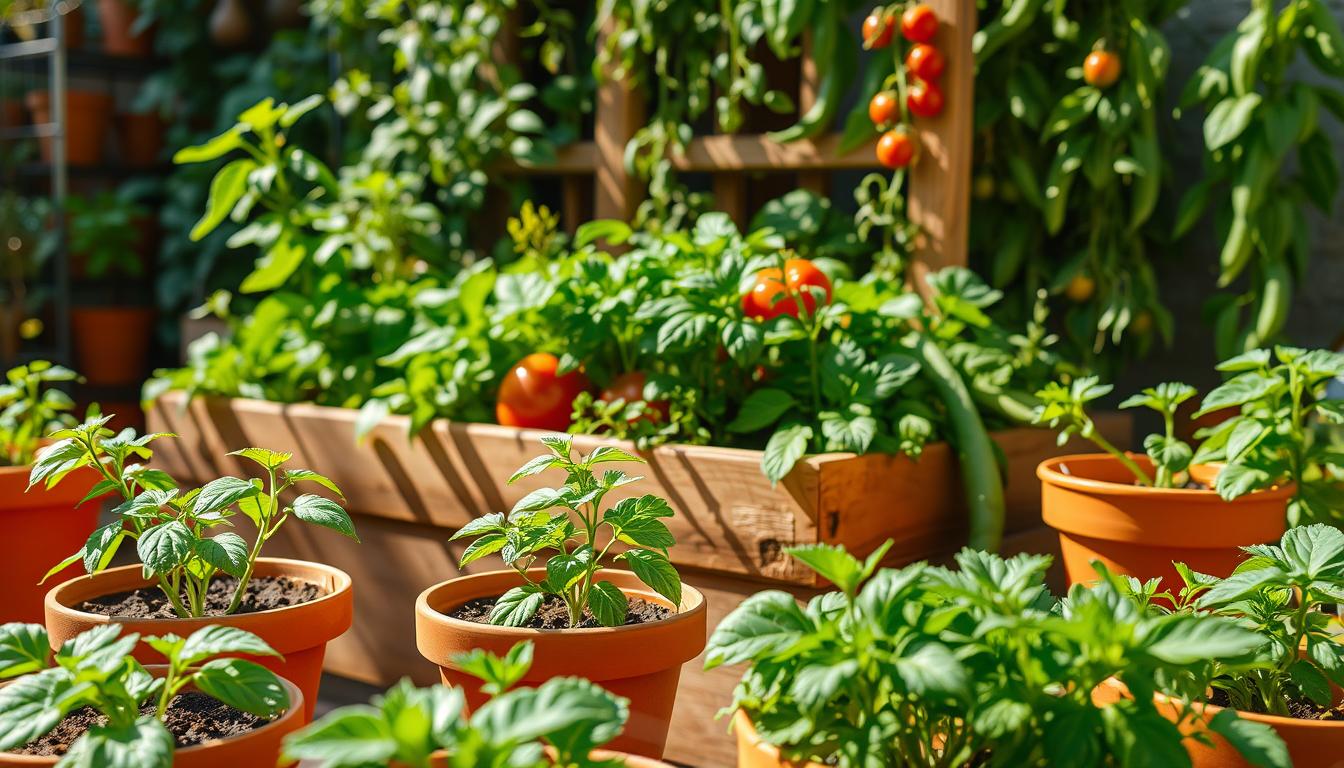Starting a garden doesn’t need a big backyard. You can grow veggies, herbs, and fruits in small spaces like balconies or patios. This method is great for city folks and those with little outdoor room. It lets you enjoy fresh food and connect with nature at home.
More than 30 veggies and herbs can grow well in containers. You can grow tomatoes, peppers, and leafy greens. This way, you can have enough food for a small family. It’s also easy to start with, needing little space and fitting your lifestyle.
Key Takeaways
- Vegetable container gardening is a great way to grow your own food in small spaces
- Over 30 different types of vegetables and herbs can thrive in containers
- Container gardening is perfect for urban dwellers and those with limited outdoor space
- Vegetable container gardening can be adapted to fit your lifestyle and preferences
- With the right containers, soil, and care, you can create a productive garden that yields fresh produce
- Vegetable container gardening is a beginner-friendly gardening method that requires minimal space
- Container gardening allows for better control over growing conditions and can help mitigate the risk of soil-borne diseases
Starting your vegetable container gardening journey is exciting. You’ll learn about its benefits like saving space and money. You’ll also find out what you need to begin, like containers, soil, and veggies. Plus, you’ll learn how to pick the best ones for you.
Benefits of Vegetable Container Gardening
Vegetable container gardening has many benefits. It’s great for those with little space or who want to grow their own food. With apartment gardening, you can turn a small area into a garden. This way, you get fresh produce right at your door.
One big plus of container gardening is how it saves space. You can use it on balconies, patios, or even windowsills. This makes the most of your space.
It’s also perfect for small space gardening, ideal for city living. You can grow many vegetables, like leafy greens and herbs. Even fruiting plants like tomatoes and peppers can thrive in pots. Growing vegetables in pots lets you control their environment. You can ensure they get the right sunlight, water, and nutrients.
- Space efficiency and flexibility
- Cost-effective food production
- Control over growing conditions
These advantages make container gardening a great choice. It’s perfect for anyone wanting to start a garden, no matter the size of their space.
Essential Container Gardening Supplies
For a successful balcony garden, the right supplies are key. You’ll need a few important items to start. First, get high-quality potting soil made for containers. This soil is light and drains well, ideal for your garden containers.
A good potting soil has compost, sand, and perlite. Adding a granular fertilizer will help your plants grow. You’ll also need containers that are 6-8 inches deep, depending on the vegetable. Lettuce and spinach need shallow containers, while carrots and peppers need deeper ones.
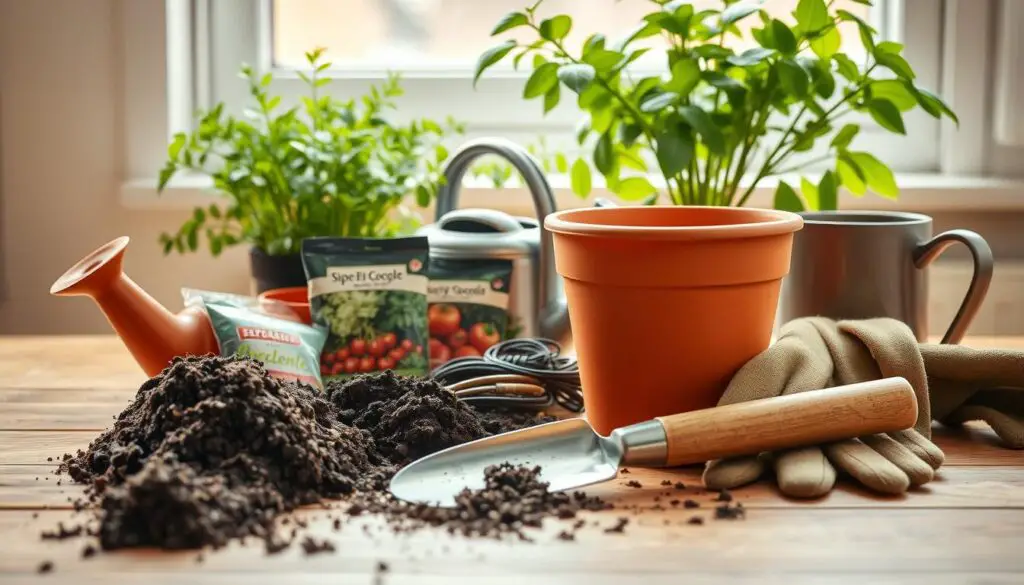
Other must-haves include seeds, water, and tools like water sticks and hand-held claws. These tools help with aeration. With these supplies, you’re ready to grow a vibrant patio garden. Soon, you’ll enjoy fresh veggies right in your backyard or balcony.
To succeed in container gardening, pick the right containers, soil, and supplies. Think about what your plants need, like container depth and soil type. Follow these tips and use the right supplies for a thriving garden. You’ll have fresh produce all season.
Choosing the Right Containers for Your Vegetables
Choosing the right container is key for growing veggies in pots. The size of the container depends on the veggies you want to grow. For big veggies like tomatoes, you need a container that’s at least 8-10 gallons deep and 12-16 inches tall.
Smaller veggies like herbs or leafy greens do well in smaller spaces. They can grow in containers with 1-3 gallons of soil and a depth of 4-6 inches. Make sure the container is big enough for the roots to spread out.
Some veggies, like potatoes, need a lot of room and a deep container. Others, like strawberries, can do well in shallower containers. The material of the container also matters. It affects the soil’s temperature and how well it drains. Terracotta, glazed ceramic, and stoneware are good choices.
Drainage is very important for container plants. Make sure your container has holes for water to drain. You can also use a potting mix that drains well to avoid waterlogging. The right container helps your veggies thrive, even in a small space.
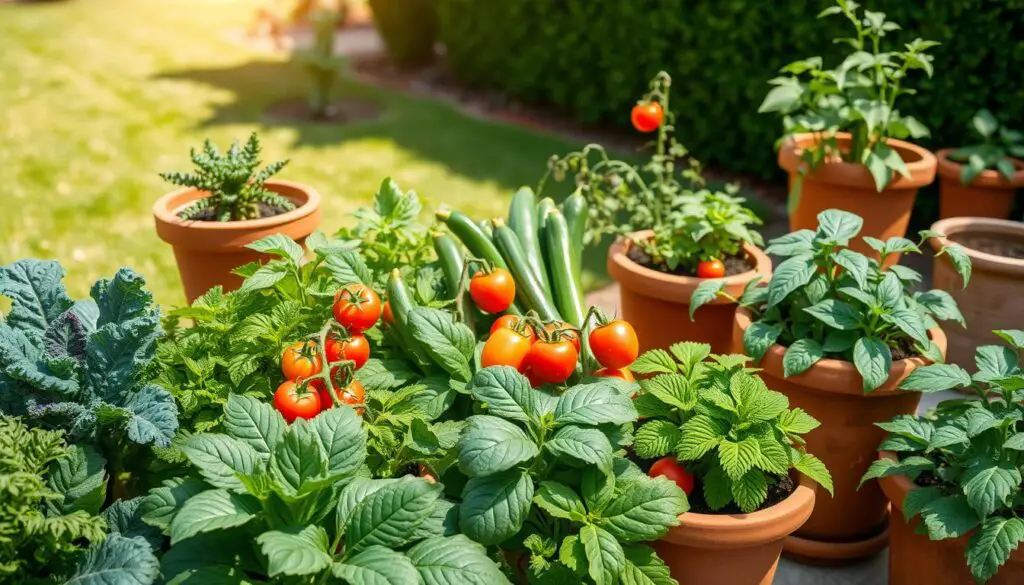
| Vegetable Type | Minimum Container Size | Depth |
|---|---|---|
| Large Vegetables | 8-10 gallons | 12-16 inches |
| Medium Vegetables | 4-6 gallons | 8-12 inches |
| Small Vegetables | 1-3 gallons | 4-6 inches |
Best Soil Mix for Container Vegetables
Urban gardening needs the right soil mix for container veggies. As a beginner, you want a mix that’s easy to use and feeds your plants well. It should have the right pH, nutrients, and handle moisture and water.
A mix of peat, compost, and vermiculite is best. This mix, called Pea-Ver-Comp, gives your plants what they need. Adding perlite or worm castings can make it even better.
Optimal Soil Components
A good soil mix has the right mix of ingredients. Here are the key ones:
- Peat: keeps moisture in and weeds out
- Compost: adds nutrients and improves soil
- Vermiculite: helps with drainage and air
- Perlite: stops water from pooling
pH Balance and Nutrients
The pH of your soil is important. Most veggies like a slightly acidic to neutral soil, between 6.2 and 7.0. You can check your soil’s pH with a kit and adjust it if needed.
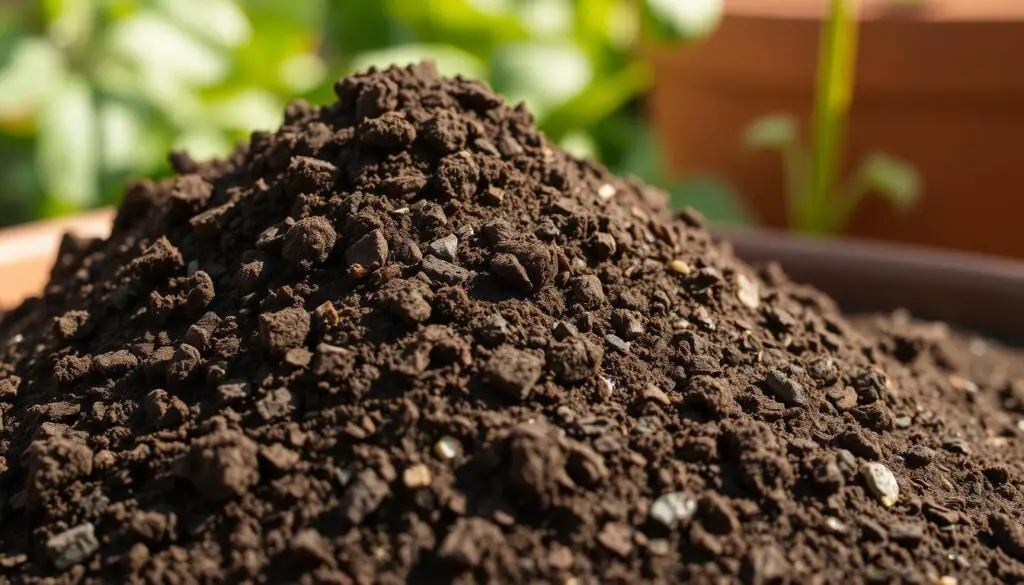
Pre-Mixed vs Custom Soil Blends
Pre-mixed soils are easy, but custom blends give you more control. You can mix peat, compost, and vermiculite yourself. Then, add other ingredients as you like.
| Soil Mix | Ingredients | pH Level |
|---|---|---|
| Pea-Ver-Comp | Peat, Compost, Vermiculite | 6.2-7.0 |
| Custom Blend | Peat, Compost, Perlite, Worm Castings | 6.2-7.0 |
Understanding Light Requirements
In small space gardening, knowing how much light your plants need is key. Most veggies need 6-8 hours of direct sunlight daily for best growth. Leafy greens can handle less light, but tomatoes and peppers need full sun. Growing vegetables in pots lets you move them for better light.
Think about the type of veggie you’re growing to figure out light needs. For instance, tomatoes and peppers need 6 hours of direct sun. Lettuce and spinach do well in partial shade. Here’s a quick guide:
- Full sun: 6-8 hours of direct sunlight
- Partial shade: 4-6 hours of direct sunlight
- Shade: less than 4 hours of direct sunlight
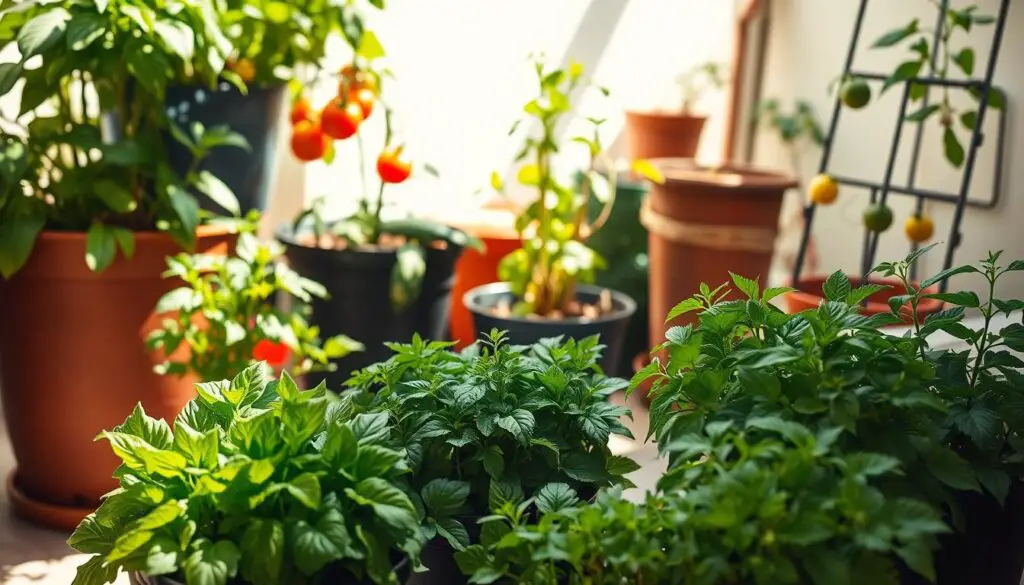
Knowing your plants’ light needs helps you grow a great small space garden, even with little sunlight. With the right light and care, you can harvest fresh, tasty veggies. Plus, you get to enjoy the perks of growing vegetables in pots and small space gardening.
| Vegetable | Light Requirement |
|---|---|
| Tomatoes | Full sun |
| Peppers | Full sun |
| Lettuce | Partial shade |
| Spinach | Partial shade |
Best Vegetables for Container Gardens
Choosing the right vegetables for your container garden is key. You need varieties that do well in containers and handle patio garden conditions. Leafy greens, root vegetables, and fruiting plants are top picks.
Leafy greens and herbs need a container with at least 2 gallons of soil. They’re great for balcony gardens and ready to harvest in 20 days. Favorites include lettuce, spinach, and basil.
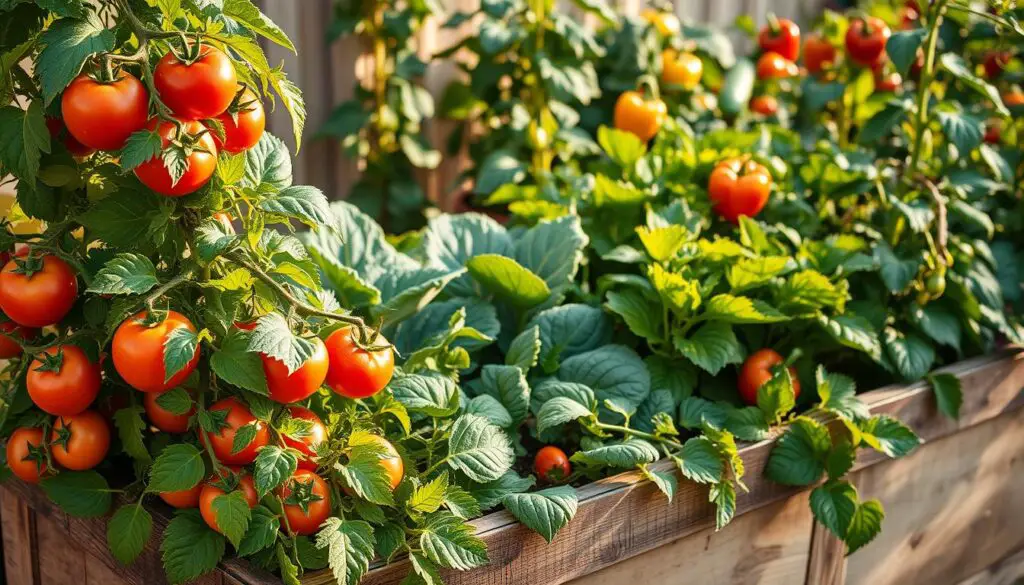
Root vegetables like carrots and beets need deeper containers with 5 gallons of soil. They like well-draining soil and sun to partial shade. Fruiting plants, such as tomatoes and peppers, require large containers with 10 gallons of soil and full sun.
Consider using self-watering planters to cut down on watering. Also, think about companion planting to boost growth. With the right choices and techniques, your patio garden can thrive, even in small spaces.
Watering and Feeding Your Container Garden
Starting your urban gardening journey means learning about watering and feeding your plants. Vegetables need plenty of water to grow, but too much can harm them. Finding the right balance is key for beginners.
Watering depends on several things like the plant, its size, the container, and where it’s placed. Big containers hold more water, so they need less watering. Small containers, on the other hand, dry out faster because they have less soil and more sun.
Here are some tips for watering and feeding your container garden:
- Water at the base of the plant, not on the leaves, to avoid diseases.
- Keep watering until water flows out of the drainage holes to moisten the soil well.
- Use a slow-release fertilizer to feed your plants with each watering.
- Check your plants’ nutrient levels and adjust your fertilizer schedule as needed.
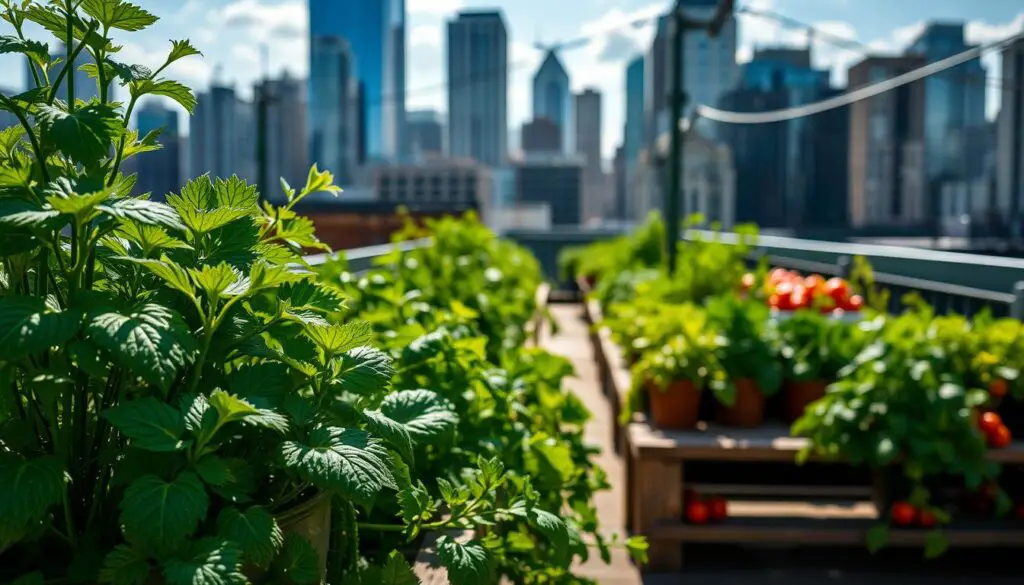
By following these tips and knowing your plants’ needs, you can make your urban garden thrive. It will give you joy and fresh produce all season.
| Plant Type | Watering Frequency | Fertilization Schedule |
|---|---|---|
| Leafy Greens | Every 2-3 days | Weekly with a balanced fertilizer |
| Fruiting Vegetables | Every 3-4 days | Every 2 weeks with a high-phosphorus fertilizer |
Common Problems and Solutions in Container Vegetable Gardens
Growing vegetables in pots can be very rewarding. But, you should know about common problems in small space gardening. One big issue is pests. You can fight them with organic methods like introducing beneficial insects or using neem oil.
Another big problem is diseases. You can prevent them by using a special soilless potting mix for containers. This mix helps avoid soil-borne diseases and keeps your plants healthy. Also, remember that container gardens dry out faster, so they need more water.
Pest Management Strategies
Here are some ways to manage pests in your container garden:
- Check your plants often for pests
- Use physical barriers to keep pests away
- Bring in beneficial insects to control pests
- Use organic pesticides only when necessary
Disease Prevention Tips
To keep diseases away from your garden, follow these tips:
- Choose a soilless potting mix made for containers
- Make sure your containers drain well to avoid soggy soil
- Don’t overwater, as it can cause root rot and other diseases
- Keep your containers clean and sanitized to stop disease spread
By knowing these common problems and how to solve them, you can have a successful container vegetable garden. Even in a small space, you can grow a lot of food.
| Common Problem | Solution |
|---|---|
| Pests | Use organic pest management methods, such as introducing beneficial insects |
| Diseases | Use a soilless potting mix and provide adequate drainage |
| Environmental Stress | Water frequently and provide support for plants as needed |
Conclusion: Starting Your Container Vegetable Garden Journey
Starting your vegetable container garden is exciting. You get to grow your own food, even in small spaces. With the right tools, soil, and care, your balcony or windowsill can become a garden paradise.
Remember, gardening is all about trying new things and learning. It’s about finding what works best for you. This guide has given you the basics to start your garden.
You now know how to pick the best containers and soil. You also understand how much light your plants need and how to fix common issues. Start your garden, enjoy the little wins, and watch it grow. Happy gardening!
FAQ
What is vegetable container gardening and what are its benefits?
Vegetable container gardening means growing veggies, herbs, and other edible plants in pots. It’s great because it saves space, is cost-effective, and lets you control the growing conditions.
What are the essential supplies needed for a successful container vegetable garden?
You’ll need good potting soil, fertilizers, and the right pots for a container garden. Make sure the pots are the right size, made of the right material, and have good drainage.
How do I choose the best soil mix for my container vegetables?
The right soil mix is essential for your veggies. It should be rich in nutrients, drain well, and have the right pH. You can buy a pre-mixed soil or make your own with compost, vermiculite, and perlite.
What are the best vegetables to grow in containers?
Great choices for containers include leafy greens, herbs, and root veggies like carrots and radishes. Also, consider fruiting plants like tomatoes, peppers, and eggplants. Pick varieties that grow well in small spaces.
How often should I water and fertilize my container vegetable garden?
Water and feed your garden based on the plants, pot size, and weather. Check the soil moisture often and water when it’s dry up to two inches. Use a balanced fertilizer regularly, following the instructions.
How can I prevent and manage common problems in my container vegetable garden?
To avoid pests, diseases, and stress, use natural pest control and monitor for disease. Also, ensure your plants get enough light and water correctly to keep them healthy.
